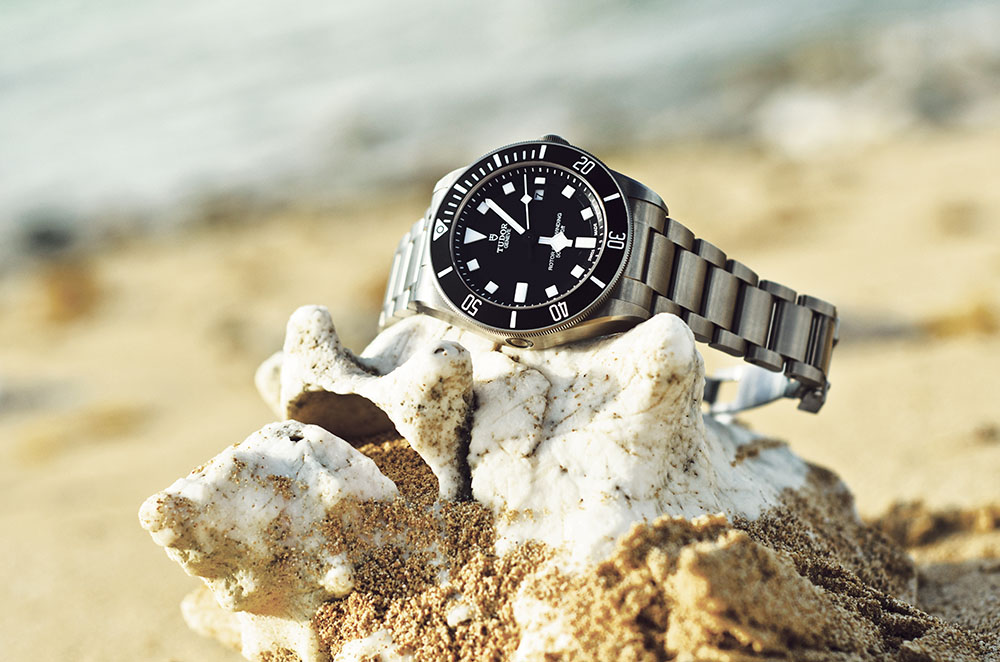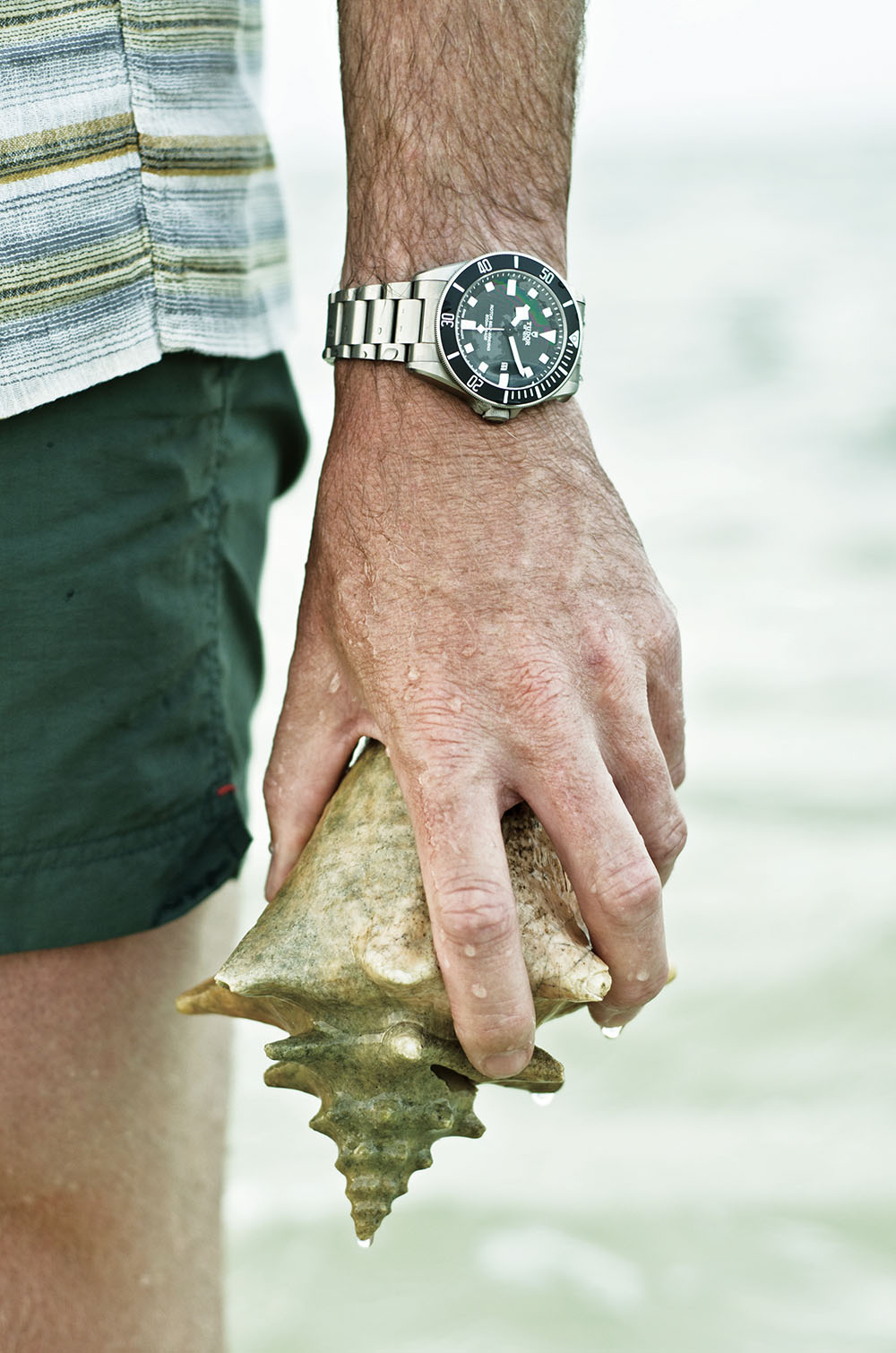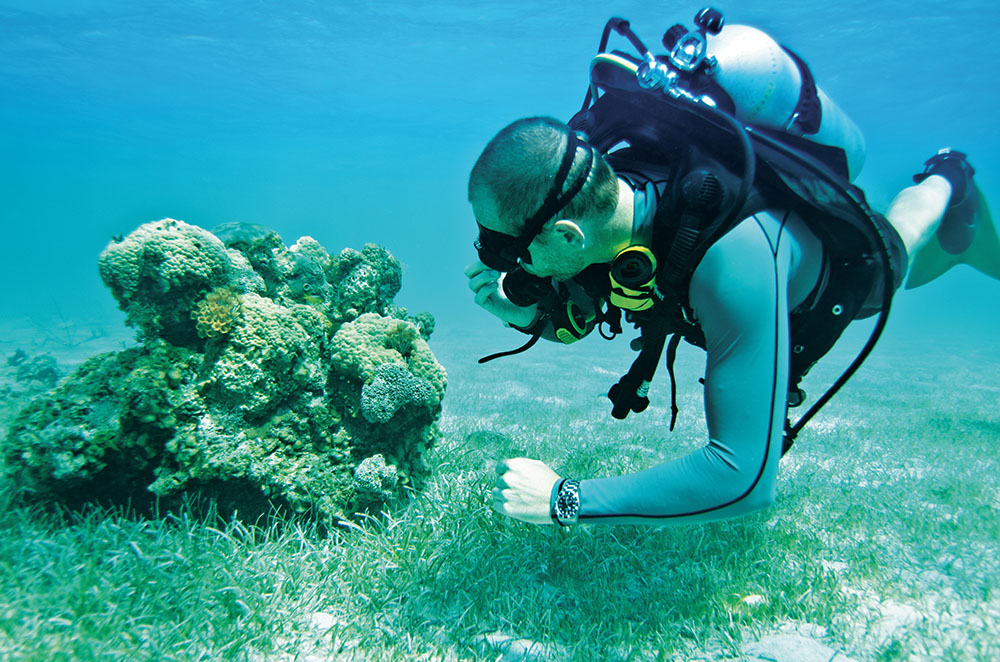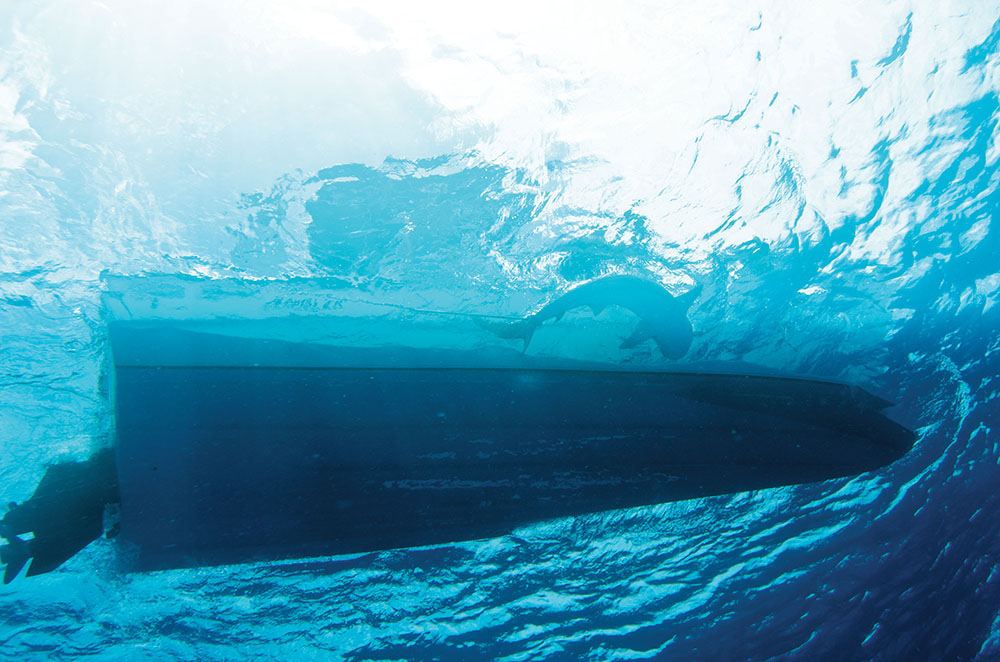Tudor
Bottom Time: Tudor Pelagos
Motoring slowly along the line of buoys, five of us leaned over the starboard gunwale, scanning the clear water through polarized lenses. It had been a quiet day with no sharks in sight — unless you count the lazy nurse sharks begging for bait scraps in the marina. We’d spent languid hours between line checks bobbing in the shallows, trading stories and baking in the sun. The boat had no canopy and there was little breeze, so the only respite we could have was to splash over the side for a cooling snorkel. The batteries in the monitoring equipment only had a four-hour lifespan, so if we didn’t hook a shark by now, it would be time to head in for the day.
As we squinted through the surface reflections, someone called out, “Shark on the line!” The boat sprang into action, everyone with a job, readying the syringes, marking the tag number and maneuvering the boat. I spat in my dive mask, made sure my air supply was on and sat on the gunwale in my fins, waiting for the go sign. “It’s a big one, a tiger.” I gave the bezel on my Tudor Pelagos a spin to mark zero time, grabbed the camera and backrolled over the side into the water.
If you want to study sharks, one of the best places to base your operations is the Bahamas. The necklace of 3,000 islands dangling just 50 miles east of Florida is known for its healthy population of apex predators, thanks to the forward-thinking conservation efforts of the country’s government and its warm, Gulf Stream-bathed waters that teem with life. Reef, coastal and pelagic sharks visit these islands often and have played starring roles in movies from the James Bond franchise to YouTube videos. It seemed a perfect place to tag along with a team of shark researchers and get up close with the misunderstood, feared and endangered fish, as well as to test out Tudor’s latest dive watch, the Pelagos.
As anyone who hasn’t been asleep under a coral head for the past year knows, Tudor is returning to America. The company, which used to be better known for being “the affordable Rolex” than for its distinctive timepieces, is coming back to our shores with a new strategy and a quiver of impressive, unique watches. Aside from its breakthrough duo of Heritage chronographs, Tudor released two dive watches at BaselWorld last year, each entirely different, but both of which immediately caught the fancy of dive-watch fans. While the Heritage Black Bay is clearly an homage to Tudor’s historical Submariner models, complete with gilt dial writing, the old Tudor rose logo and a domed crystal, the Pelagos is a distinctly modern watch, in terms of materials, build quality and innovations.
Tudor was founded by none other than the founder of Rolex, Hans Wilsdorf, in 1946 to be an affordable alternative to Rolex, using the parent company’s cases but fitting them with third-party movements to keep prices lower. With a few exceptions, the early Tudor watches largely mimicked Rolex models, and even sometimes bore the Rolex name and logo on the caseback and crown. It wasn’t long after the introduction of the Rolex Submariner in 1954 that Tudor came out with its own version, also called the Submariner. The two watches looked identical, from their bezels to their crowns and “Mercedes” hands.
By the 1970s, Rolex Submariners ascended to luxury-icon status and would rarely see bottom time in the ocean. Meanwhile, the Tudor version filled the niche of the true tool watch for real divers, given its affordability and easily serviced, reliable ETA movement. Several navies issued Tudor Submariners to their divers, including the US Navy to its elite SEALs, and the French to their famous Marine Nationale. The watches of this latter group have become extremely desirable to collectors, due to the military markings, blue dial and bezel, and the now-famous “snowflake” hands that really set the watch apart from its Rolex counterpart.
No one is quite certain where the idea for the snowflake hands came about, or why Tudor decided to offer this alternative to the iconic Rolex Mercedes hands, but this style of hands, with the blocky diamond shape on the hour and sweep seconds, proved far more legible at a glance than the skinny Mercedes hands. The design also provided a distinguishing feature for Tudor from its more prestigious sibling, and has been revived by Tudor in its latest dive-watch offerings.
The Pelagos really represents the latest iteration in the evolution of the Rolex family’s dive watch since its introduction six decades ago, and perhaps what the Submariner would have become were Rolex not constrained by the iconic styling that ensured the virtually eternal popularity of its Submariner. It is a return to pure, uncompromising tool-watch roots, with features and materials that might not appeal to the average luxury-watch buyer.
First of all, its case is constructed of aerospace-grade titanium, a material ideally suited for use in a dive watch. Titanium is highly corrosion-resistant, amagnetic and extremely robust, in addition to being lightweight.
The Pelagos represents the first titanium watch from Tudor — and Rolex, though the material is used for the caseback of the Rolex Deepsea Sea-Dweller. For a first go at it, Tudor gets it right, and exhibits the same expert casemaking that Rolex has demonstrated in its steel cases. Bevels are crisp and exquisitely polished, with tall, slab-sided lugs that terminate at starboard in pointed crown-guards. The crown itself, like those used on countless previous Tudor dive watches, is the vaunted Rolex Triplock — perhaps the most proven and reliable dive-watch crown in history. Case and crown together provide water-resistance to 500m — although, given Rolex’s penchant for understatement, I suspect it could go twice as deep.
On the port side of the case is something never before found on a Tudor: a gas-release valve — another technology inherited from Rolex. While necessary only to commercial divers working in underwater, helium-saturated habitats, the device nonetheless makes a statement about Tudor’s intention with this watch: it’s all business. This is further enunciated by the fact that the watch — from dial to case to bezel — is entirely matte-finished. There is not a shiny, reflective bit on the timepiece. I appreciated this trait as I splashed into the Atlantic, facing the prospect of an ornery, struggling tiger shark.
After the bubbles from my backroll cleared and I became oriented, I quickly descended under the 30-foot Angler boat; there, I caught sight of the shark for the first time. Despite being close to nine feet long, the male tiger shark was still a juvenile and had not yet developed the impressive girth of a mature adult. The telltale stripes that give it its name, and blunt nose, were visible as the creature fought on the line. I swam under the boat and pivoted around to face the shark. Even from 20 feet deep, the famously clear Bahamian water gave me a clear view up to the scientists on deck, who were struggling to restrain the shark long enough to take its blood, measure its length and attach a tag to its dorsal fin. I could see Owen, the burly Brit, looping a rope around the tail, while Brendan stuck a needle in its back to draw a blood sample.
The goal of this project was to study the stress effects of long-line fishing on sharks of various species, as measured through visual observation and blood testing. Some sharks do better than others, such as those that can pump water over their gills without swimming. Others, like the reef and deepwater pelagic sharks, get exhausted quickly and don’t last as long on a hook, since they rely on movement to “breathe”. This tiger shark was not doing well, and the team hurried to do their work before releasing it. I hovered just below as they flipped the shark over, which put it into a calm state known as tonic immobility, and prepared to cut out the hook that was lodged in the side of its mouth. Soon it would be free and I could only imagine what it would think of me when it was time to swim away.
The Pelagos is a great example of how the evolution of a concept reaches its peak when all but the most essential elements are stripped away. If a dive watch is meant to be durable, legible and able to track elapsed time, then this Tudor does it better than almost any other. The three-dimensional applied dial markers lack shiny surrounds, filling all available space with luminescent Chromalight paint that glows blue after exposure to the slightest light source. To date, this may be the best lume of any dive watch I have tested, almost doubling as a dive torch at night or in dark swim-throughs. The hands are the iconic snowflake hands, one of the few nods to historical Tudors on this modern watch, and they are similarly luminous and very legible. The timing bezel is titanium, with a matte-black ceramic insert bearing fully luminous markings all the way around. The bezel is tight and precise in its anticlockwise movement, as pleasurable to operate as the combination lock on a Swiss bank vault.
While the Pelagos is provided with a rubber strap, the titanium bracelet is so well made that I never gave a thought to swapping it out for diving. The full titanium bracelet drapes well on the wrist, and the metal’s immunity to temperature conductivity gives it a softer feel on the skin than steel. But the pièce de résistance of the Pelagos bracelet is its clasp, a stainless-steel and titanium feat of engineering that rivals anything Rolex or anybody else has produced. Three micro-adjustment notches allow for a quick and precise fit on the fly, while a floating “free adjustment” setting allows the clasp to expand or shrink with the girth of a wrist. This is especially appreciated when the watch is worn over a neoprene wetsuit, which is compressed by water pressure as a diver descends. The spring-loaded clasp takes in the slack during descent, and conversely lets it out upon ascent. Though I only dove in a thin dive skin, I found the floating clasp useful in the hot Bahamian sun to accommodate my expanding and increasingly sunburned wrist.
Viewed from my silent vantage point beneath the boat, the shark-tagging operation almost appeared serene, with the rays of the dappled sunlight backlighting the scene above me. I suddenly thought to look around me, in case any other curious sharks arrived to investigate. But only a queen triggerfish swam past, oblivious to the commotion, and I returned my attention to the surface. I could see Brendan lean over the side with a large bolt cutter to cut the barb off the hook in the shark’s mouth. With the business end of this magnificent fish free, they flipped it over and Owen released its tail. The shark came to life once again and turned away from the boat. My heart pounded in my chest as it angled above where I was hovering in the water column. But without even a glance toward me, the tiger shark coasted directly over my head like a massive airplane, blocking out the sun briefly, and I watched it pass. With one quick flick of its tail, it was gone, swimming out toward the reef wall and into the depths. I glanced at my pressure gauge: I’d breathed through half my tank. The dive felt like an eternity, but a look at the Pelagos on my wrist told me I was only underwater for nine minutes. With one more look over my shoulder, I kicked for the surface and the sunlight above.















